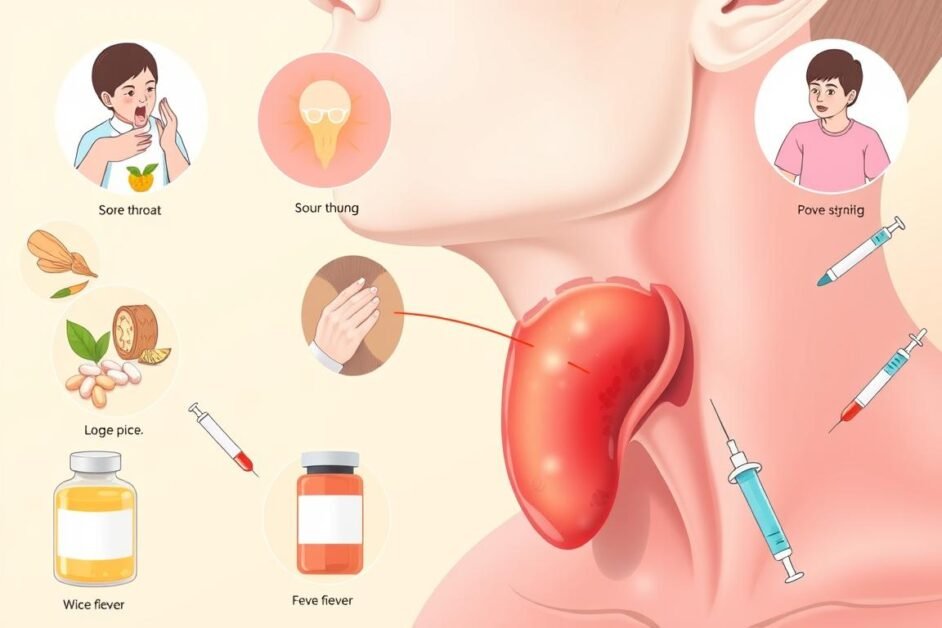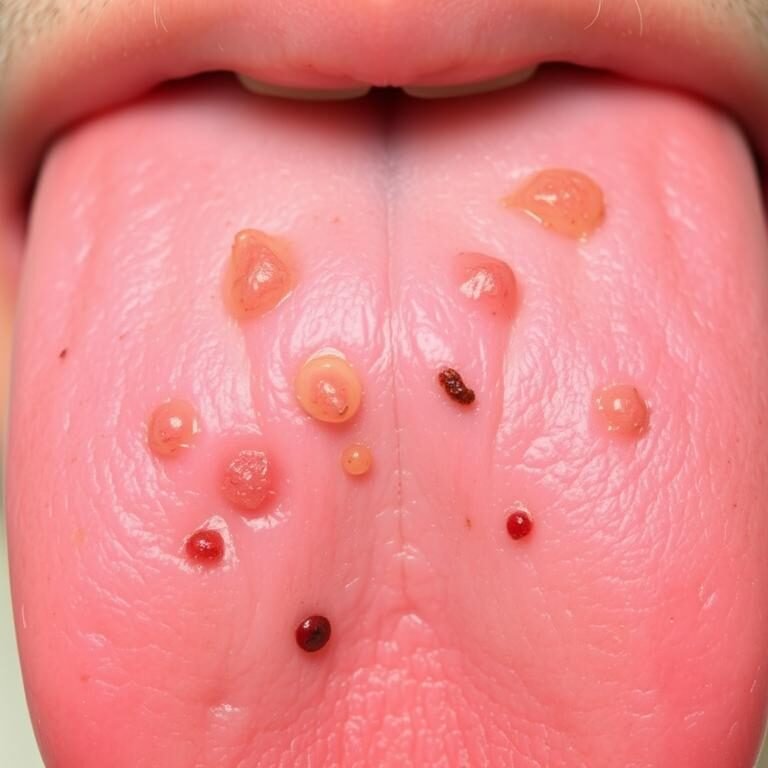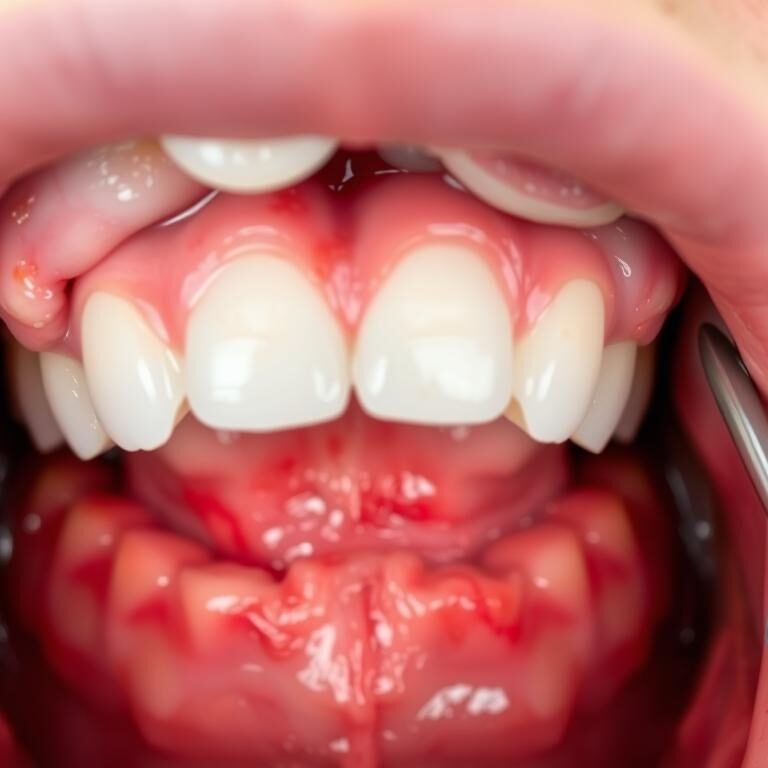Tonsillitis can feel like an unwelcome guest, hitting our young ones hard. Imagine your child struggling to eat, swallow, or even talk because their throat feels like sandpaper. This common problem mainly hits kids from preschool to mid-teen years. About 30% of kids with recurring respiratory infections get tonsillitis.
Viral infections cause about 70% of tonsillitis cases. Bacterial infections, like *Streptococcus pyogenes*, are responsible for the other 30%. It’s key to know the signs and treatments for tonsillitis. By understanding the symptoms and prevention methods, we can protect our children’s health. Let’s explore the basics of tonsillitis together.
What is Tonsillitis?
Tonsillitis is when the tonsils get inflamed. Tonsils are oval-shaped tissues at the throat’s back. Most cases, about 70%, are caused by viruses. Bacteria like Streptococcus pyogenes also play a big role.
The tonsils help fight off infections. So, they can easily get infected.
The tonsil disease symptoms can vary a lot. They can range from mild to severe pain. This pain can make swallowing and breathing hard.
Children between 5-15 years old are most often affected. Symptoms can come on quickly. For bacterial tonsillitis, they usually last 3 to 4 days but can go up to two weeks.
If not treated, bacterial tonsillitis can cause serious problems. These include rheumatic fever or kidney infections. Knowing what tonsillitis is and its symptoms is key to managing it.
If symptoms keep coming back, getting treatment is even more critical. For more on taking care of your tonsils, check out this guide on mouthwash for tonsil stones
Understanding the Symptoms of Tonsillitis
The symptoms of tonsillitis can vary a lot, depending on age and cause. In kids, signs include a very sore throat, red swollen tonsils, and fever. They might also have trouble swallowing, making it hard to eat and drink.
Younger kids might get fussy or drool because of the pain. This is a common sign in them.
Swollen lymph nodes can also show tonsillitis. Spotting these signs early is key to getting the right treatment. Adults can get tonsillitis too, but it’s less common and might be milder.
Knowing the symptoms of tonsillitis helps in getting a quick diagnosis and treatment. This is important for both kids and adults to get the care they need.
| Age Group | Common Symptoms | Notes |
|---|---|---|
| Children (2-15 years) | Severe sore throat, swollen tonsils, fever, difficulty swallowing, drooling | Almost every child experiences tonsillitis at least once. |
| Adults | Milder sore throat, swollen tonsils, possible fever | Less common than in children; symptoms are usually mild. |
| Younger Children (Under 5) | Fussiness, refusal to eat, drooling | More prone to viral tonsillitis. |
Common Tonsillitis Symptoms
Tonsillitis can make everyday tasks hard. Knowing the signs is key to getting help fast. Here are the main symptoms:
Swollen Tonsils
Swollen tonsils are a clear sign. They might look red and inflamed. You might see white or yellow spots, which mean infection.
Children often get tonsillitis more easily. So, it’s important for parents to watch for these signs closely.
Sore Throat
A sore throat often goes with swollen tonsils. The pain can be really bad, making it hard to eat or drink. This symptom is a big problem for both kids and adults.
Difficult or Painful Swallowing
As tonsillitis gets worse, swallowing can hurt. This might make you not want to eat or drink. Kids might get dehydrated easily.
It’s a good idea for caregivers to keep an eye on how much fluid they drink. Giving them soft foods can help too.
Fever and Headache
Fever is common with tonsillitis. Headaches can happen too, from the infection or inflammation. Feeling tired and irritable is common, more so in kids.
What Causes Tonsillitis?
Tonsillitis is an inflammation of the tonsils. It can come from different sources. Knowing these causes helps in treating and managing it. Viral and bacterial tonsillitis need different treatments.
Viral Causes
Viral infections are the main causes of tonsillitis. Common viruses include:
- Adenovirus
- Influenza
- Epstein-Barr virus (known for causing mononucleosis)
Most tonsillitis cases come from viruses. Symptoms usually go away in 3 to 4 days. There’s no vaccine to prevent these viruses.
Bacterial Causes
Bacterial tonsillitis is less common but serious. It’s often caused by group A Streptococcus bacteria. Untreated, it can lead to complications. Antibiotics are used to treat it, helping symptoms and preventing spread.
Knowing about bacterial tonsillitis is key. It’s important to see a doctor if symptoms last more than 4 days.
Other Contributing Factors
Several factors increase the risk of tonsillitis, such as:
- Age (more common in children and young adults)
- Frequent germ exposure, often in crowded places
- Weakened immune systems
Preventing infections is important. Handwashing and avoiding shared items can help a lot.
| Type of Tonsillitis | Main Causes | Treatment Options |
|---|---|---|
| Viral Tonsillitis | Adenovirus, Influenza, Epstein-Barr | Symptomatic relief, no antibiotics needed |
| Bacterial Tonsillitis | Streptococcus bacteria | Antibiotics, symptomatic relief |
| Contributing Factors | Age, immune status, environment | Preventative measures, proper hygiene |
Is Tonsillitis Contagious?
Tonsillitis is common, mostly in kids. It’s not contagious itself, but the infections that cause it are. About 70% of cases come from viruses, which spread through droplets and surfaces. Knowing how tonsillitis transmission works is key to stopping it, like in schools or camps.
Kids aged 5 to 15 face a higher risk of bacterial tonsillitis. This is caused by Streptococcus pyogenes, found in 15-30% of cases. Viral germs causing tonsillitis spread easily, so keeping clean is vital. Signs like red tonsils and fever mean you’re sick and should stay clean.
Symptoms of tonsillitis last 3 to 4 days but can go up to 2 weeks. This is a high-risk time, mainly for young kids and those living together. Teaching kids to wash hands often and not share things can help stop tonsillitis.
| Infection Type | Transmission Method | Contagiousness |
|---|---|---|
| Viral Infections | Respiratory droplets, contact with contaminated surfaces | High |
| Bacterial Infections | Saliva, respiratory droplets | Moderate |
Understanding tonsillitis transmission helps manage and lower its occurrence, mainly in at-risk groups. Changing toothbrushes after getting sick can also prevent getting sick again.
Diagnosing Tonsillitis
Diagnosing tonsillitis requires a detailed check-up by a healthcare provider. They will look at your throat for swollen tonsils, fever, and other signs. A throat swab is often used to find streptococcal bacteria. This helps in diagnosing tonsillitis.
A blood test might also be needed. It helps tell if the infection is viral or bacterial. This is key for the right treatment.
Children often get tonsillitis many times. This is important when diagnosing tonsillitis. Viral infections are common, but bacterial ones are a big problem in kids aged 5 to 15. Early diagnosis is vital to avoid complications.
Knowing the symptoms like a sore throat helps doctors diagnose tonsillitis. A throat swab can tell it apart from other viruses. After 24 hours on antibiotics, you won’t spread the bacteria anymore. This shows why early treatment is so important.
| Symptoms Evaluated | Diagnostic Procedure |
|---|---|
| Swollen tonsils | Physical examination |
| Sore throat | Throat swab |
| Fever | Complete blood count |
| Difficult or painful swallowing | Symptom assessment |
In summary, diagnosing tonsillitis is a detailed process. It ensures accurate diagnosis. This affects treatment, helping to ease symptoms and aid in recovery.
Tonsillitis Treatment Options
Treatment for tonsillitis depends on whether it’s viral or bacterial. Knowing the right tonsillitis medication and home remedies is key. This helps in managing symptoms effectively.
Medications for Tonsillitis
Bacterial tonsillitis needs antibiotics. These are essential when group A streptococcus is involved, affecting about 30% of children’s sore throats. Viral tonsillitis, on the other hand, doesn’t respond to antibiotics. Over-the-counter pain relievers are important for tonsillitis treatment.
Home Remedies for Symptom Relief
Home remedies can ease tonsillitis discomfort. They include:
- Rest and hydration
- Warm salt gargles to soothe the throat
- Throat lozenges to alleviate pain
- Humidifiers to keep air moist
These methods offer comfort, helping during acute symptoms. Symptoms can last from 3 to 14 days. Good hygiene, as in prevention measures, also helps prevent spreading tonsillitis.
How to Treat Tonsillitis at Home
Tonsillitis can often be managed at home with several effective strategies. To treat tonsillitis at home, you can use natural remedies and self-care practices. These methods help in healing and relieving symptoms.
Natural Remedies
Several natural remedies can help with tonsillitis:
- Warm liquids: Drinking warm tea or broth can soothe the throat and make swallowing easier.
- Cold treats: Consuming ice cream or frozen pops can numb the throat and provide relief from pain.
- Saltwater gargling: Gargling with warm saltwater can reduce inflammation and discomfort.
- Steam inhalation: Utilizing a humidifier or inhaling steam from a bowl of hot water can ease breathing issues.
- Herbal remedies: Herbal teas containing honey can provide additional soothing effects.
Self-Care Tips
Good self-care is also key:
- Rest: Allowing the body to recover is important; adequate sleep helps facilitate healing.
- Hydration: Drinking plenty of fluids can prevent dehydration and keep the throat moist.
- Nutritional support: Eating nutritious foods supports the immune system; avoid irritants like spicy or acidic foods.
- Avoid irritants: Steering clear of smoke, allergens, and strong odors helps prevent further throat irritation.
While these strategies can manage symptoms, seeing a healthcare professional is important if symptoms don’t improve. Knowing how to treat tonsillitis at home helps you take care of your health.
Acute vs Chronic Tonsillitis
Tonsillitis can be broadly categorized into two types: acute tonsillitis and chronic tonsillitis. Understanding the differences between these two conditions is vital for effective treatment.
Acute tonsillitis shows sudden symptoms that last a few days to two weeks. It’s often caused by viral infections, making up 70-80% of cases. Bacterial infections, like Group A beta-hemolytic streptococcus (GABHS), cause 15-30% of cases. Symptoms include a sore throat, fever, and swollen lymph nodes.
Chronic tonsillitis, on the other hand, has recurring symptoms that can happen several times a year. Children are most affected, with symptoms appearing as often as seven to ten times a year. If a child has at least seven episodes in a year, two consecutive years with five episodes, or three episodes for three years, surgery might be recommended.
The differences in acute tonsillitis symptoms and chronic conditions influence treatment decisions. Untreated bacterial cases may lead to complications. For ongoing management and care protocols, consider visiting this resource on effective dental health strategies.
Tonsillitis and Strep Throat: What’s the Difference?
Tonsillitis and strep throat share some symptoms but have different causes. Knowing the differences is key to treating them right. Tonsillitis can come from viruses or bacteria, with 15% to 30% caused by bacteria like group A Streptococcus, which causes strep throat.
Strep throat symptoms include a very sore throat, swollen neck glands, and pus on the tonsils. These symptoms can start suddenly, with a fever over 102°F (38.9°C). Tonsillitis symptoms are more general, like a sore throat, trouble swallowing, and fever.
Getting a throat culture is key to diagnosing strep throat. Pediatric offices use rapid strep tests for quick results. A throat culture confirms strep bacteria in about 24 hours. Not treating strep throat can lead to serious problems like rheumatic fever, but this is rare in the U.S.
- Strep throat hits school-age kids, mainly between 7 to 8 years.
- Acute tonsillitis mostly affects kids aged 4–8 years and young adults 15–25 years.
- Antibiotics are needed for strep throat, but many viral tonsillitis cases get better on their own.
- Knowing the difference helps pick the best treatment.
– Strep throat needs quick medical care because it’s bacterial. Viral tonsillitis usually gets better by itself.
Choosing the right mouthwash is important for your mouth health. Ingredients and how often you use it can help your gums. Learn more about picking the best mouthwash here.
When to See a Doctor
Knowing when to see a doctor for tonsillitis is key for good treatment and to avoid problems. If symptoms last more than 48 hours, you should go to the doctor. Also, if you have trouble swallowing or breathing, and a high fever or yellow tonsils, get help right away. Young kids should see a doctor if they are very upset, not drinking enough water, or seem very tired.
Symptoms to watch for include:
- Fever of 101°F or higher lasting for several days
- Severe pain when swallowing
- Swollen lymph nodes
- Difficulty opening the mouth
- Excessive drooling, specially in young children
- Stomach symptoms with a sore throat in children
Be careful if you keep getting tonsillitis. It could mean there’s a bigger problem that needs to be checked. A serious infection called peritonsillar abscess can make it hard to swallow or breathe. If your symptoms don’t get better in four days or get worse, see a doctor. Knowing when to go to the doctor for tonsillitis can really help your treatment.
Preventing Tonsillitis: Tips and Best Practices
Keeping your throat healthy is key to avoiding tonsillitis. It’s all about avoiding germs and boosting your immune system. Washing your hands often is a big part of staying healthy.
- Don’t share things like utensils, cups, or personal items to cut down on germ spread.
- Eat foods full of fruits and veggies to help your immune system.
- Drink enough water to keep your throat moist and prevent irritation.
- Teach kids good hygiene habits for their whole life.
- Stay away from people who are sick to avoid getting infected.
Living a healthy lifestyle helps prevent tonsillitis. Exercise, sleep, and managing stress are important. Also, avoid things like smoke and pollution that can harm your throat.
Here’s a table with more tips to prevent tonsillitis:
| Prevention Tip | Description |
|---|---|
| Good Oral Hygiene | Brush teeth twice a day and use mouthwash to kill germs. |
| Stay Hydrated | Drink lots of water to keep your throat moist and reduce swelling. |
| Avoid Sharing | Don’t share drinks, food, or personal items to stop germs from spreading. |
| Healthy Diet | Eat foods rich in nutrients to strengthen your immune system and fight off infections. |
| Limit Smoking | Avoid smoking and secondhand smoke to lower throat irritation and infection risk. |
Using these tips can greatly reduce your chance of getting tonsillitis. This helps keep your throat healthy and improves your overall health.
Tonsillectomy: When is it Necessary?
Tonsillectomy is a surgery often done for chronic or severe tonsillitis. This happens when tonsillitis occurs at least seven times a year. Or five times in two years, or three times in three years. If infections cause a lot of pain or problems, surgery might be needed.
Big tonsils can also block breathing during sleep, leading to surgery. The surgery helps reduce strep throat and other infections. About 50% of people see fewer throat infections after the surgery.
Recovery from tonsillectomy takes 10 to 14 days. Patients might feel mild to severe throat pain. They might also have pain in their ears, neck, or jaw.
It’s important to watch for signs like a fever over 102°F (38.9°C). Or signs of dehydration like too much thirst and weakness. These need quick medical help.
Tonsillectomy is for those with frequent bacterial tonsillitis. Talking to a doctor helps decide if surgery is right. It can offer many benefits.
For more on related surgeries, looking into wisdom teeth removal can help. It gives a better understanding of surgical options.
Coping with Complications of Tonsillitis
Tonsillitis can lead to serious complications if not treated. These include abscesses, sleep apnea, and infections that spread throughout the body. Spotting these issues early is key to a quick recovery.
Group A Streptococcus (GAS) infections can cause rheumatic fever within 2 to 3 weeks. Patients might also get post-streptococcal arthritis within a month. In rare cases, GAS can lead to kidney problems, including failure.
Watch for signs of worsening symptoms. Look out for high fever, persistent throat pain, or trouble swallowing. Lemierre’s Syndrome, for example, can cause severe symptoms like high fever and breathing issues. It’s more common in young adults.
Quick action is needed to prevent complications from getting worse. Risks include deep neck infections or bleeding after surgery. Knowing these risks and watching for symptoms can help manage tonsillitis better.
How Long Does Tonsillitis Last?
The tonsillitis duration depends on the cause. Acute tonsillitis usually lasts 3 to 7 days. Chronic tonsillitis can last longer without treatment. Most people get better in a week with the right treatment.
Viral tonsillitis often gets better in a couple of weeks. But bacterial infections need quick antibiotic treatment. Starting antibiotics can help in 2 to 3 days. Not finishing the antibiotics can make symptoms come back.
Symptoms may get worse for the first two to three days. Then, they start to get better. If symptoms are severe or if you have trouble swallowing or breathing, see a doctor. Tests like rapid strep tests or throat swabs help find the cause. This leads to the right treatment and knowing how long tonsillitis will last.
Seeing symptoms early and getting help quickly can help you recover faster. This can also shorten the tonsillitis duration.
Understanding the Cost of Tonsillitis Treatment
The cost of treating tonsillitis can change a lot. It depends on the diagnosis and treatment needed. First, you might pay $100 to $300 for a doctor’s visit. Then, tests and images could cost more.
If a bacterial infection is found, antibiotics will add $10 to $200. More visits for ongoing symptoms can also raise the total cost.
In severe cases, surgery might be needed. A tonsillectomy, which removes the tonsils, can cost between $3,000 and $7,000. This includes hospital and anesthesia fees. The need for surgery has gone up, affecting both adults and kids.
The cost can be high, hitting families hard, even more so for those with less money. In fact, 91.7% of families in lower income groups faced huge health expenses. Knowing these costs helps families plan and get the care they need without financial worry.
FAQ
What is tonsillitis?
Tonsillitis is when the tonsils get inflamed. This can happen from a virus or bacteria. It makes your throat sore, your tonsils swell, and it’s hard to swallow.
What are the symptoms of tonsillitis?
You might have a sore throat and swollen tonsils. It’s hard to swallow, and you might have a fever or headache. Kids might drool and get fussy too.
Is tonsillitis contagious?
Tonsillitis itself isn’t contagious. But the viruses or bacteria that cause it can spread. This happens through saliva and droplets in the air.
What causes tonsillitis?
Viruses like adenovirus and influenza, and bacteria like Streptococcus, cause tonsillitis. It also depends on your age and how strong your immune system is.
How is tonsillitis diagnosed?
Doctors check your throat and look for symptoms. They might take a throat swab or do a blood test.
What are the treatment options for tonsillitis?
If it’s caused by bacteria, antibiotics are used. For viruses, rest, drinking lots of water, and pain relievers help.
What home remedies can help with tonsillitis symptoms?
Drinking warm liquids, gargling with salt water, and using throat lozenges can help. So can humidifiers, rest, and eating well.
What’s the difference between acute and chronic tonsillitis?
Acute tonsillitis comes on quickly and lasts a few days to two weeks. Chronic tonsillitis keeps coming back many times a year.
Can strep throat occur without tonsils?
Yes, strep throat can happen even if you’ve had your tonsils removed. The bacteria can infect other parts of your throat.
When should I see a doctor for tonsillitis?
See a doctor if your symptoms last more than 48 hours. Or if you have trouble swallowing or breathing. Also, if you have a very high fever or your tonsils are full of pus.
How long does tonsillitis last?
Acute tonsillitis usually goes away in 3 to 7 days. Chronic tonsillitis can last longer if not treated right.
What complications can arise from untreated tonsillitis?
Untreated bacterial tonsillitis can cause abscesses, sleep apnea, or infections that spread throughout your body. This shows why treating it quickly is important.
When is a tonsillectomy necessary?
You might need a tonsillectomy for chronic or recurring tonsillitis. This is if you get infections often or if you have complications.
What are the costs associated with tonsillitis treatment?
The cost varies based on what you need to diagnose and treat it. This includes doctor visits, tests, and medicines. If surgery is needed, it adds to the cost.











